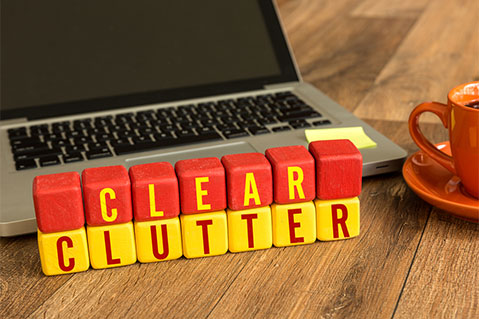Strategy March 21, 2016
Why Clutter Hurts Your Leadership & What You Can Do About It
It’s a simple fact: Clutter is postponed decisions. Here's how to get on top of it and be more effective.
Many entrepreneurs and managers have cluttered offices—unless they have an organized assistant. If you don’t believe it, just start looking around. Begin in your own organization, and then look in places like the manager’s office of your local retail store.

Entrepreneurs and managers think “big picture,” but following through on details can be a struggle. They like to start things, but finishing them can be a challenge. Often the more brilliant a person is, the messier their office. Sorting and filing seems like a lower priority than creating a new product or serving your customer. But is it? It’s easy for observers to wonder, “If someone can’t manage their own office, how can they manage a department or a company?”
According to a 2010 study by Brother International, the cost of messy desks and time spent looking for misplaced items in corporate America is about $177 billion annually. That price tag, figuring the time spent daily hunting for misplaced files, staples or documents, added up to 76 hours—or nearly two work weeks—a year. According to the same study, it also takes a toll on pocketbooks, since nearly one-third of those surveyed failed to get reimbursed for a business or travel expense because they misplaced or lost a receipt.
Half of any job is using the right tool. Here are six tools you can use to eliminate the clutter in your office, and accomplish your work and enjoy your life:
1. In/Out/File. Place three containers on your desk within reach of your chair.
- One for the items you haven’t looked at yet.
- One for items you need to take someplace else—another person’s office, the post office, etc.
- One for items you need to file in a location within your own office that you can’t reach from your chair.
2. Wastebasket/Recycle/Shred. Make it easy to get rid of what you don’t need. For example, if you have a shredder, but you can’t reach it from your chair, use a desk drawer, or a small box under your desk. Then develop a system for actually getting the paper shredded—whether you do it yourself or have an employee do it.
3. Calendar. One of the biggest contributors to a messy desk is papers that serve as reminders to do something. Keeping an open calendar on your desk for making direct entries can help eliminate this issue. While most of us are great at making appointments with other people, we’re not so good at making appointments with ourselves. We need to care for ourselves in order to meet the needs of others.
4. Contact Management System. Another big source of office clutter is papers (and electronic files) with contact information—names, addresses, phone numbers, e-mails, etc.
5. Action Files. These files should be located close to your desk. They contain the papers you need to work on your current projects. They can be sorted in three different ways:
1. By date (files labeled 1-31 for the current month, and January to December)
2. By type of action (e.g., “Data Entry” “Expense Reimbursement,” “Waiting for Response”)
3. By name of project, client, or event
Most people have a combination of the three. For example, the August 15 file might remind you to write a new ezine, while the project file labeled “Ezine Ideas” would contain the information you need to actually write it.
6. Reference Files. These files contain all the papers you may not need on a daily basis, but don’t want to throw away. They can be located in or outside your office. Your “To File” box will serve as a place to hold the papers that need to be filed.
Some projects may have both an Action File and a Reference File. The Action File will contain the papers you are currently using on a project, while the Reference File will contain the completed papers that you want to retain for historical or legal purposes.
So here’s your challenge: Set aside four hours. Clear your desk by putting everything on it in a box.
No one likes to think about maintenance—but unless you figure out how you can maintain any system, you will fail. You can buy a Lamborghini, but if you don’t complete the necessary maintenance, you will soon have a pile of junk. You can go to a health spa and lose a lot of weight, but maintaining good exercise and good eating habits are essential if you don’t want to gain back everything you lost. One way to think of maintenance is “plan + habits.”
If you know yourself well enough to know you won’t maintain it, and you want your office to reflect the quality of the products and services you provide, hire someone to help a few hours a week. Your office will look better, you will feel better, and your leadership will shine.
Barbara Hemphill is the founder of Productive Environment Institute, in Raleigh, N.C., a nationally recognized speaker and author of Less Clutter More Life. As one of the country’s leading productivity and organizational experts she has helped many corporations, such as Staples, Hallmark and 3M, increase their productivity and efficiency. For information about her speaking services, visit www.BarbaraHemphill.com.
